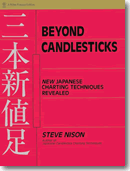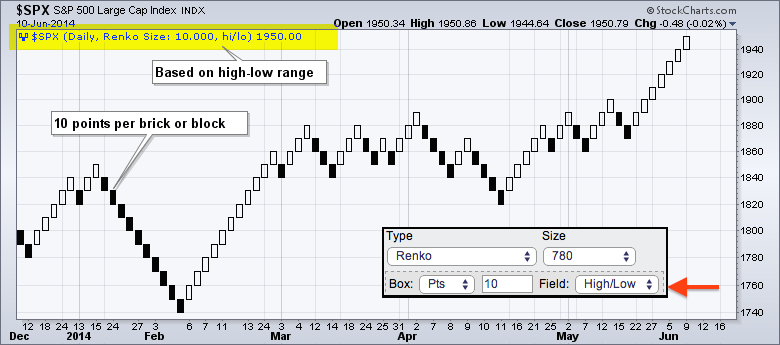原文地址:https://school.stockcharts.com/doku.php?id=chart_analysis:renko
Introduction
Invented in Japan, Renko charts ignore time and focus solely on price changes that meet a minimum requirement. In this regard, these charts are quite similar to Point & Figure charts. Instead of X-Columns and O-Columns, Renko charts use price “bricks” that represent a fixed price move. These bricks are sometimes referred to as “blocks” or “boxes.” They move up or down in 45-degree lines with one brick per vertical column. Bricks for upward price movements are hollow while bricks for falling price movements are filled with a solid color (typically black).
由日本范明的Renko图标忽略了时间,只关注满足最低需要的价格变化。在这个方面,这些图表与点状图非常相似。
与x列和o列不同,Renko图使用使用代表固定价格变动的价格“砖块”。这些砖块有时被称为“砖块”或“盒子”。它们以45度的直线向上或向下移动,每个垂直柱上有一块砖。 用于价格上涨的砖是空心的,而用于价格下跌的砖则用纯色(通常为黑色)填充。
Construction and Characteristics
Renko charts are based on bricks with a fixed value that filters out smaller price movements. A regular bar, line or candlestick chart has a uniform date axis with equally spaced days, weeks and months. This is because there is one data point per day or week. Renko charts ignore the time aspect and only focus on price changes. If the brick value is set at 10 points, a move of 10 points or more is required to draw another brick. Price movements less than 10 points would be ignored and the Renko chart would remain unchanged.
Renko图表是基于一个固定值的砖块,它过滤掉了较小的价格变动。一个规则的条形图、直线图或烛台图的日期轴是相同间隔的日、周和月。这是因为每天或每周都有一个数据点。Renko图表忽略了时间方面,只关注价格变化。如果砖的值设置为10点,则需要移动10点或更多才能抽出另一块砖。低于10点的价格变动将被忽略,Renko图表将保持不变。
Using the S&P 500 10-point Renko chart as an example, a new Renko brick would not be drawn if the S&P 500 were at 1840 and advanced 9 points to 1849. If the S&P 500 then advanced to 1850 the very next day, a new Renko brick would be drawn because the entire move was at least 10 points. This brick would extend from 1840 to 1850 and be hollow, or white in this example. Alternatively, if the S&P 500 declined from 1840 to 1830, a new Renko brick would be drawn and it would be solid, or black in this example.
以标普500指数10点Renko图为例,如果标普500指数在1840点,并上升9点至1849点,就不会画出新的Renko砖。如果标普500指数第二天就涨到1850点,那么一个新的Renko砖就会出现,因为整个走势至少是10点。这个砖从1840点延伸到1850点,是空心的,在本例中是白色的。或者,如果标准普尔500指数从1840点下跌到1830点,那么将绘制一块新的Renko砖,它将是实心的,或者在本例中是黑色的。

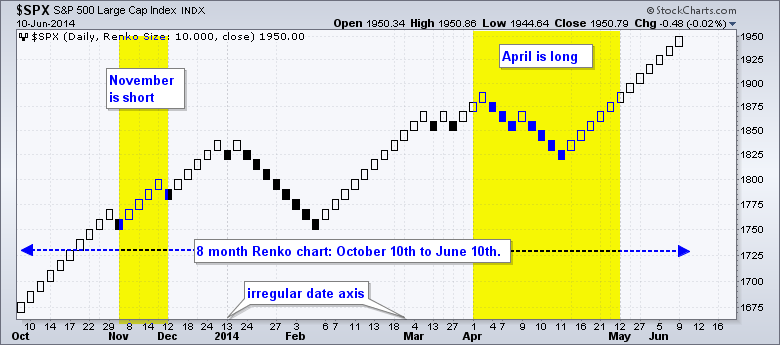
The two charts above cover a six-month timeframe, but the Renko chart sports an irregular date axis and the price action is less choppy. This is because the S&P 500 Renko chart ignores price moves that are less than 10 points and remains unchanged until there is a move of at least 10 points.
上面的两张图表涵盖了六个月的时间框架,但Renko图表呈现了一个不规则的日期轴,价格走势没有那么起伏。这是因为标准普尔500指数忽略了低于10点的价格变动,并且在至少有10点变动之前保持不变。
Close Versus High-Low Range
Renko charts can be based on closing prices or the high-low range by using the “field” setting in SharpCharts. Closing price means there is one data point per period and less volatility. The high-low range puts two data points into play and increases the fluctuations, which results in added bricks. The examples below show Renko charts for the S&P 500 and the box size is set at 10-points for both. The first chart is based on closing prices and the second is based on the high-low range. Notice that the Renko chart based on the high-low range fluctuates more than the close-only Renko chart.
Renko图表可以基于收盘价或使用sharpharts中的“field”设置的高低区间。收盘价意味着每个周期有一个数据点,波动性较小。高低范围使两个数据点发挥作用,并增加波动,从而增加砖块。下面的例子展示了标准普尔500指数的Renko图表,两者的方框大小都设置为10点。第一个图表是基于收盘价,第二个图表是基于高低点区间。请注意,基于高低区间的Ranko图比仅收盘价的Ranko图波动更大。
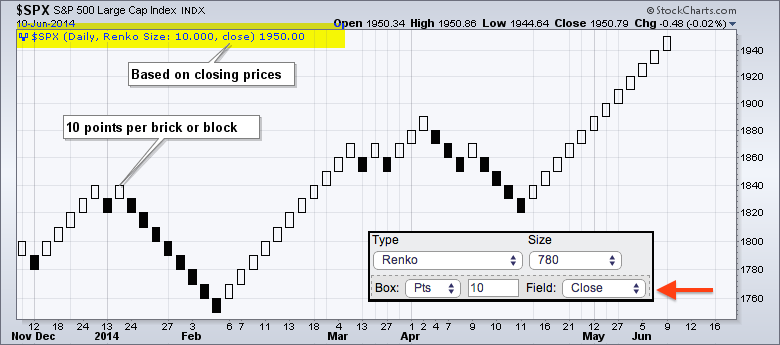
Fixed Value versus ATR
Chartists can use the “box” settings to set brick size as a specific value or as the Average True Range (ATR). A specific point value means brick size will remain constant even as new data is incorporated into the chart. In other words, new price data is added every trading day and the brick size will remain constant. The two charts above have a fixed value and each brick represents ten points.
图表专家可以使用“box”设置来将砖块大小设置为一个特定的值或平均真实范围(ATR)。一个特定的点值意味着即使将新数据合并到图表中,砖的大小也将保持不变。换句话说,每个交易日都会添加新的价格数据,而砖块的大小将保持不变。上面的两个图表有一个固定的值,每个砖块代表十个点。
In contrast to fixed price bricks, using ATR values results in the fluctuating brick sizes. The default ATR is based on 14 periods and the Average True Range fluctuates over time. The brick size is based on the ATR value at the time the chart is created. Should the ATR value change the next day, then this new ATR value will be used to set the brick size. Also note that ATR values are based on standard charts, such as close-only, bar and candlestick. These charts have one data point per period and a uniform x-axis (date axis). The ATR value shown on these charts can differ from the ATR brick value on a Renko chart due to rounding issues.
与固定价格砖不同,使用ATR值会导致砖尺寸波动。默认ATR基于14个周期,平均真实范围随时间波动。块大小基于创建图表时的ATR值。如果ATR值在第二天发生变化,那么这个新的ATR值将用于设置砖块的大小。还要注意,ATR值是基于标准图表的,例如close only、bar和candlestick。这些图表每个周期有一个数据点和一个统一的x轴(日期轴)。由于舍入问题,这些图表上显示的ATR值可能与Renko图表上的ATR砖值不同。
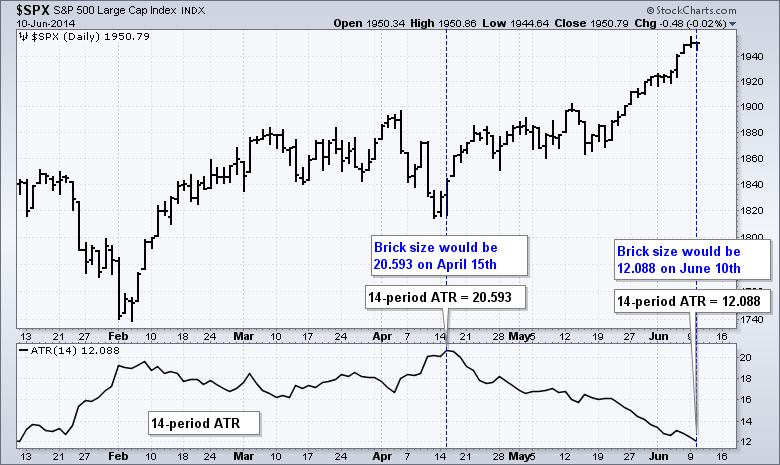
The next two examples show how the ATR value changes when the ending chart date changes. The first chart ends on June 10th and the ATR value is 12.05, which is the value for each Renko brick. The second chart ends on April 15th and the ATR value is 20.55, which is the value for each Renko brick. Notice how the brick value changed as the ATR value changed. The bricks on April 15th have a much higher value than the bricks on June 10th.
下面两个示例显示ATR值在结束图表日期变化时如何变化。第一个图表结束于6月10日,ATR值为12.05,这是每个Renko砖块的价值。第二张图结束于4月15日,ATR值为20.55,这是每个Renko砖块的值。注意砖块的值是如何随着ATR值的变化而变化的。4月15日的砖块比6月10日的砖块有更高的价值。
Trends, Support and Resistance
White bricks form when prices rise a certain amount and black bricks form when prices decline a certain amount. The image below shows a daily S&P 500 chart with 10-point bricks and a 10-period simple moving average. Note that a 10-period moving average calculation is based on the last ten Renko values, not the last ten trading days. An indicator on a Renko chart is based on Renko values and will differ from the same indicator on a bar chart. Chartists can typically use shorter moving averages on Renko charts because smaller price movements have been filtered out.
价格上涨到一定程度时形成白砖,价格下跌到一定程度时形成黑砖。下图显示的是标普500日线图,有10个点的砖块和10期简单移动平均线。注意,10期移动平均线的计算是基于最近10个Renko值,而不是最近10个交易日。Renko图上的指标是基于Renko值的,与柱状图上的相同指标会有所不同。图表分析师通常可以在Renko图表中使用较短的移动平均线,因为较小的价格波动已经被过滤掉了。

Chartists can use troughs to mark support levels and peaks to mark resistance levels. Chartists can also look for a two brick reversal to signal a trend change. Notice how the index fell with five black bricks in August and again in September-October. These declines looked like falling flags. A reversal occurred when two white bricks formed and broke above the short-term resistance level. Chartists can also apply the Fibonacci Retracements Tool to Renko charts.
图表学家可以用波谷来标记支撑水平,用峰值来标记阻力水平。图表学家也可以寻找两块砖的反转来暗示趋势的变化。请注意,该指数在8月份和9-10月份分别以5块黑色砖头下跌。这些下跌看起来像是飘落的旗帜。当两块白砖在短期阻力位以上形成并突破时,出现反转。图表学家也可以将Fibonacci回溯工具应用于Renko图表。
Conclusions(结论)
Like their Japanese cousins (Kagi and Three Line Break), Renko charts filter the noise by focusing exclusively on minimum price changes. Renko bricks are not added unless price changes by a specific amount. As with Point & Figure charts, it is easy to spot important highs and lows, and identify key support and resistance levels. Armed with this information, chartists can identify uptrends with higher highs and higher lows or downtrends with lower lows and lower highs. As with all charting techniques, chartists should employ other technical analysis tools to confirm or refute their findings on Renko charts.
像他们的日本兄弟(Kagi and Three Line Break)一样,Renko图表通过专注于最小的价格变化来过滤噪音。除非价格发生了特定的变化,否则Renko砖块不会被添加。与点和图一样,很容易发现重要的高点和低点,并确定关键的支撑和阻力水平。有了这些信息,图表分析师就能识别出带有更高的高点和更高的低点的上升趋势,或者带有更低的低点和更低的高点的下降趋势。与所有的图表技术一样,图表分析师应该使用其他技术分析工具来证实或驳斥他们在Renko图表上的发现。
SharpCharts
Chartists can create Renko charts by going to the “Chart Attributes” section and selecting Renko as the chart “Type”. This section is just under the SharpChart on the left side. Users will then be able to choose between points or ATR, and then set the parameters for these two options in the next box.
图表师可以通过转到“图表属性”部分并选择Renko作为图表“类型”来创建Renko图。这个部分就在左边的sharphart下面。然后用户可以在点或ATR之间进行选择,然后在下一个框中为这两个选项设置参数。
The “ATR” setting uses the Average True Range indicator from the symbol's underlying bar chart to determine an “Automatic” value for the Renko chart's box size. Note: This ATR value might change as prices change which can cause the Renko chart to change significantly whenever it is updated.
“ATR”设置使用符号底层柱状图的Average True Range指标来确定Renko图的框大小的“自动”值。注意:这个ATR值可能会随着价格的变化而变化,这可能会导致Renko图在更新时发生显著变化。
The “field” can be set at close or high-low range. Chartists looking for more sensitivity can choose the high-low range. Chartists looking to focus on end-of-day price data can choose the close. The brick colors can also be changed using the “up color” and “down color” drop down menus just below the SharpChart. Click here for a live example.
“字段”可设置在接近范围或高-低范围。寻找更高灵敏度的图表分析师可以选择高-低范围。关注收盘价格数据的图表分析师可以选择收盘点位。砖的颜色也可以通过使用“上颜色”和“下颜色”下拉菜单来改变。点击这里查看一个活生生的例子。
Note: If the phrase “AT LIMIT” appears at the top of a chart, it means that the box size specified would result in a chart that is too large for us to display. In that case, we increase the box size to the smallest size we can successfully display and add the “AT LIMIT” message to the top of the chart.
注意:如果短语“AT LIMIT”出现在图表的顶部,这意味着指定的框大小会导致图表太大,我们无法显示。在这种情况下,我们将框的大小增加到我们能够成功显示的最小大小,并将“AT LIMIT”消息添加到图表的顶部。
Frequently Asked Questions
Q: Why are the Renko bricks changing on my chart?
为什么我的图表Renko的砖会发生变化
A: If you are using the ATR box size, the box size is computed automatically. However it may change during the day, so the chart may change along with it.
如果使用的是ATR盒尺寸,则会自动计算出盒尺寸。然而,它可能在一天中发生变化,因此图表也可能随之改变。
Further Study
As the name implies, this book goes beyond candlesticks to show chartists other technical analysis techniques that originated in Japan. Nison devotes an entire chapter to Renko charts; additionally, he covers Three Line Break charts, Kagi charts and explains how Japanese traders use moving averages.
顾名思义,这本书超越了烛台,向图表分析师展示了其他起源于日本的技术分析技术。Nison用了整整一章的篇幅来介绍Renko图表;此外,他涵盖了三个线突破图,Kagi图,并解释了日本交易员如何使用移动平均线。
